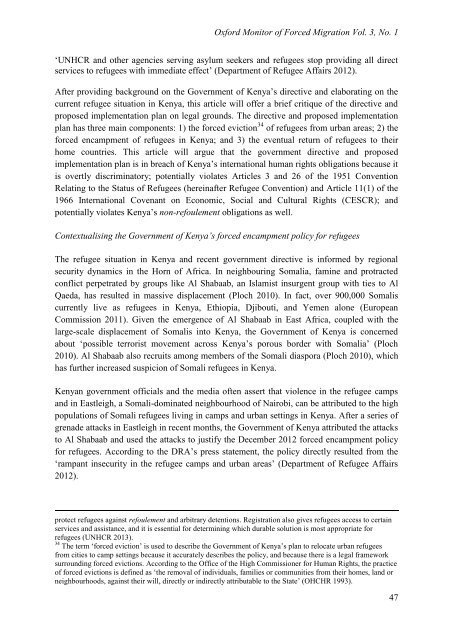OxMo-Vol.-3-No.-1
OxMo-Vol.-3-No.-1
OxMo-Vol.-3-No.-1
Create successful ePaper yourself
Turn your PDF publications into a flip-book with our unique Google optimized e-Paper software.
Oxford Monitor of Forced Migration <strong>Vol</strong>. 3, <strong>No</strong>. 1<br />
‘UNHCR and other agencies serving asylum seekers and refugees stop providing all direct<br />
services to refugees with immediate effect’ (Department of Refugee Affairs 2012).<br />
After providing background on the Government of Kenya’s directive and elaborating on the<br />
current refugee situation in Kenya, this article will offer a brief critique of the directive and<br />
proposed implementation plan on legal grounds. The directive and proposed implementation<br />
plan has three main components: 1) the forced eviction 34 of refugees from urban areas; 2) the<br />
forced encampment of refugees in Kenya; and 3) the eventual return of refugees to their<br />
home countries. This article will argue that the government directive and proposed<br />
implementation plan is in breach of Kenya’s international human rights obligations because it<br />
is overtly discriminatory; potentially violates Articles 3 and 26 of the 1951 Convention<br />
Relating to the Status of Refugees (hereinafter Refugee Convention) and Article 11(1) of the<br />
1966 International Covenant on Economic, Social and Cultural Rights (CESCR); and<br />
potentially violates Kenya’s non-refoulement obligations as well.<br />
Contextualising the Government of Kenya’s forced encampment policy for refugees<br />
The refugee situation in Kenya and recent government directive is informed by regional<br />
security dynamics in the Horn of Africa. In neighbouring Somalia, famine and protracted<br />
conflict perpetrated by groups like Al Shabaab, an Islamist insurgent group with ties to Al<br />
Qaeda, has resulted in massive displacement (Ploch 2010). In fact, over 900,000 Somalis<br />
currently live as refugees in Kenya, Ethiopia, Djibouti, and Yemen alone (European<br />
Commission 2011). Given the emergence of Al Shabaab in East Africa, coupled with the<br />
large-scale displacement of Somalis into Kenya, the Government of Kenya is concerned<br />
about ‘possible terrorist movement across Kenya’s porous border with Somalia’ (Ploch<br />
2010). Al Shabaab also recruits among members of the Somali diaspora (Ploch 2010), which<br />
has further increased suspicion of Somali refugees in Kenya.<br />
Kenyan government officials and the media often assert that violence in the refugee camps<br />
and in Eastleigh, a Somali-dominated neighbourhood of Nairobi, can be attributed to the high<br />
populations of Somali refugees living in camps and urban settings in Kenya. After a series of<br />
grenade attacks in Eastleigh in recent months, the Government of Kenya attributed the attacks<br />
to Al Shabaab and used the attacks to justify the December 2012 forced encampment policy<br />
for refugees. According to the DRA’s press statement, the policy directly resulted from the<br />
‘rampant insecurity in the refugee camps and urban areas’ (Department of Refugee Affairs<br />
2012).<br />
protect refugees against refoulement and arbitrary detentions. Registration also gives refugees access to certain<br />
services and assistance, and it is essential for determining which durable solution is most appropriate for<br />
refugees (UNHCR 2013).<br />
34 The term ‘forced eviction’ is used to describe the Government of Kenya’s plan to relocate urban refugees<br />
from cities to camp settings because it accurately describes the policy, and because there is a legal framework<br />
surrounding forced evictions. According to the Office of the High Commissioner for Human Rights, the practice<br />
of forced evictions is defined as ‘the removal of individuals, families or communities from their homes, land or<br />
neighbourhoods, against their will, directly or indirectly attributable to the State’ (OHCHR 1993).<br />
47


